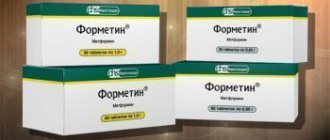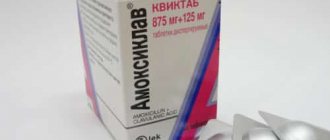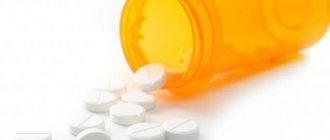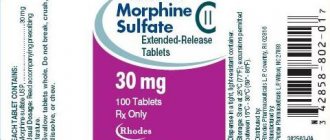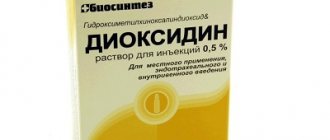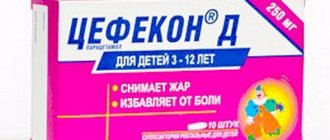Release form and composition
Available in the following dosage forms:
- Solution for intravenous and intramuscular injections. The ampoules are sold in cardboard packages, five pieces each.
- Syrup for oral use. Produced in 100 ml dark glass bottles, in cardboard boxes.
- Pills. Sold in blisters of 5 and 10 pieces each, in cardboard packs.
| Solution | 1 amp. |
| Clemastine | 2 mg |
| Syrup | 5 ml |
| Clemastine fumarate | 670 mcg |
| What corresponds to the content of clemastine | 500 mcg |
| Excipients: sodium saccharin, propyl p-hydroxybenzoate, methyl p-hydroxybenzoate, disodium hydrogen phosphate, potassium dihydrogen phosphate, propylene glycol, sorbitol 70%, mixture of fruit flavoring additives (ABRAC S-2718), demineralized water. | |
| Pills | 1 table |
| Clemastine hydrofumarate | 1.34 mg |
| What corresponds to the content of clemastine | 1 mg |
| Excipients: lactose monohydrate, corn starch, talc, povidone, magnesium stearate. | |
Indications for use
- hives;
- allergic rhinitis;
- acute and chronic eczema;
- hay fever (hay fever or pollen allergy;
- itchy dermatoses;
- contact dermatitis;
- drug allergic reaction;
- insect bites;
- anaphylactoid reactions;
- allergic and pseudo-allergic reactions (in case of blood transfusion, when using histamine or radiocontrast agents for diagnostic purposes);
- angioedema, including angioedema;
- anaphylactic shock.
Contraindications
- lower respiratory tract diseases, bronchial asthma;
- taking MAO inhibitors;
- individual intolerance to the drug;
- children under one year of age;
- pregnancy;
- lactation period (breastfeeding).
People suffering from the following pathologies should take it with caution:
- bladder neck obstruction;
- narrowing (stenosis) of the pylorus of the stomach;
- angle-closure glaucoma;
- prostatic hyperplasia accompanied by urinary retention;
- diseases of the cardiovascular system;
- arterial hypertension.
What can be replaced
Analogues of Diphenhydramine in ampoules are Tavegil, Suprastin, Chloropyramine. The cost of Tavegil in ampoules is about 200 rubles. Suprastin in the form of injections costs about 150 rubles. And Chloropyramine costs about 130 rubles. Their active ingredients are different, but the effects of these drugs are the same.
If a sane person does not independently replace a drug that is used in the form of injections, without the recommendation of his attending physician, then patients often choose tablets on their own. Although this is also unacceptable, since you can cause significant harm to your body. Therefore, we will consider several main analogues of Diphenhydramine in tablets.
Kalmaben
Antihistamine. The active component of the drug is diphenhydramine. Available in the form of white tablets. The medicine is intended for systemic use and has a hypnotic and sedative effect. In addition, the drug eliminates allergy symptoms. It is a good substitute for Diphenhydramine.
For patients over twelve years of age, it is allowed to take one tablet orally, about half an hour before bedtime, with a sufficient volume of liquid. The therapeutic course can last no more than two weeks. If necessary, the doctor may prescribe re-treatment. For allergies, medicine is prescribed for the same age category. The dosage in this case is 1 tablet no more than three times a day. Treatment lasts one and a half to two weeks.
The most common side effects include drowsiness and difficulty concentrating. There is a possibility of general weakness, headaches, and arterial hypotension. Sometimes the oral cavity may feel dry, vision blurred, nausea and a gag reflex appear, and deviations in urine output are observed. There are rare cases where allergies manifest themselves on the surface of the skin.
Improper use of this medicine leads to dependence on it.
In pharmacy kiosks, medicine is dispensed according to a doctor's prescription. Its cost is from 8 Russian rubles.
From reviews of patients who took Kalmaben, it follows that the medicine can create a lethargic effect the next day after taking it. This is especially pronounced if the sleep was short.
Dramamine
Another analogue of Diphenhydramine in tablets without a doctor’s prescription is a drug with an active substance called dimenhydrinate. The medicine creates an antiemetic and antinausea effect, prevents the synthesis of acetylcholine, eliminates dizziness, and has a sedative, anti-allergic, and local anesthetic effect.
Prescribed for:
- prevention or therapy of kinetosis, sea and airborne diseases;
- providing assistance in eliminating manifested deviations in the vestibular apparatus;
- eliminating dizziness and nausea;
- used in the treatment of Meniere's disease.
Patients over the age of twelve are prescribed 50–100 mg no more than three times a day. When preventing kinetosis, it is recommended to take the same dose half an hour before the trip. Dramamine is allowed to be taken per day in an amount not exceeding 400 mg.
Young patients whose age ranges from 1 to 6 years are prescribed from 12.5 to 25 mg of the drug, distributed over three doses. Older children can be given 25–50 mg three times a day. The dosage of the drug can be set and adjusted by the attending physician. The medication should be taken before meals.
Dramamine should not be used by patients who have individual sensitivity to the components of the drug, those suffering from epilepsy, seizures, acute dermatosis, children under one year of age, women during pregnancy and nursing mothers.
Particular care must be taken in patients suffering from angle-closure glaucoma, hyperplasia, gastrointestinal ulcers, and cervical obstruction.
In case of an overdose, a feeling of dryness appears in the nose and mouth, breathing slows down, and confusion appears in consciousness. In such situations, it is recommended to urgently rinse the stomach and take activated charcoal.
This drug can be purchased at the pharmacy without a prescription, its cost is from 130 Russian rubles. The price depends on the manufacturer and packaging.
Many patients claim that Dramamine eliminates symptoms, but does not cure the disease itself. Before you start taking this drug, you should consult your doctor to determine the dosage that is right for you.
In any case, when choosing what to replace Diphenhydramine with, you should follow the recommendations of your doctor.
Until recently, one of the most common drugs used in various emergency cases in adults and children was Diphenhydramine. This is a fairly cheap medicine that effectively relieves pain, inflammation, swelling, and allergic reactions. In addition, Diphenhydramine has sedative properties. But this drug causes many side effects. Therefore, recently they have practically abandoned it. It is believed that it is better to use some analogue of Diphenhydramine, which is just as effective, but safer. The emergence of new drugs has made it possible to abandon many old drugs. Although in hospital settings Diphenhydramine is still often used to relieve allergic attacks.
Instructions for use
The price, analogues and side effects of this medicine are now known mainly to doctors. In recent years, it has been almost impossible to buy Diphenhydramine at a pharmacy. Although previously it was used very widely even for young children. Now this drug is available not only in tablets or injection solution. You can use rectal suppositories, a suspension for children, or an external allergy remedy - Psilo-Balm. Any analogue of Diphenhydramine, like the drug itself, is contraindicated in the following cases:
- with peptic ulcer;
- pathologies of the bladder;
- epilepsy;
- prostatic hyperplasia;
- during breastfeeding;
- children under 7 months.
- weakness, drowsiness;
- deterioration of psychomotor reactions;
- dizziness, euphoria;
- excitement, irritability;
- convulsions, epileptic seizures, tremors;
- impaired coordination of movements;
- dry mucous membranes;
- decreased blood pressure;
- heart rhythm disturbances.
- "Allergin";
- "Diphenhydramine Bufus";
- "Diphenhydramine Vial";
- "Grandim";
- "Psilo-balm."
- spasms of smooth muscles of internal organs are relieved;
- capillary permeability decreases;
- pain goes away;
- the urge to vomit decreases;
- allergic reactions are prevented;
- itching, allergic rhinitis goes away;
- the patient calms down and falls asleep easier.
- anaphylactic shock;
- Quincke's edema;
- urticaria, hay fever;
- angioedema;
- conjunctivitis;
- vasomotor rhinitis;
- dermatitis with severe itching;
- chorea;
- seasickness;
- insomnia.
- the most common mixture is “Troichatka”. It includes "Diphenhydramine", "Analgin" and "Papaverine". It is used to reduce blood pressure and temperature, relieve pain after injuries and surgeries, and in other emergency cases. But recently, an analogue of Diphenhydramine, Loratadine, is increasingly being included in this mixture.
- Boyko's mixture is also an effective medicine. It is used to relieve severe pain in diseases of the musculoskeletal system. Its main components are “Analgin” and “Diphenhydramine”. They are rarely replaced with analogues, as they are more effective. Other components are added depending on the situation. These can be “Papaverine”, “Novocaine”, “No-Shpa”, “Prozerin”, vitamin B12.
Why is Diphenhydramine used less frequently?
Diphenhydramine, which is the basis of this drug and its analogues, often has negative effects on patients. Although this substance is eliminated from the body within 24 hours, it manages to cause considerable harm. Therefore, it is very dangerous to take Diphenhydramine on your own, without a doctor’s testimony. It is especially not recommended for use by young children and people who need increased concentration at work. Any analogue of Diphenhydramine containing the same active ingredients gives the following side effects:
How to buy an analogue of Diphenhydramine without a doctor's prescription
It is now very difficult to buy this drug in a pharmacy. Although it costs a penny - about 30 rubles for 10 pieces. Suppositories and children's suspension are a little more expensive, but a doctor's prescription is required to purchase. Indeed, due to the fact that in large doses the drug has a hallucinogenic effect and causes euphoria, it was often used by drug addicts. If you really need to buy an analogue of Diphenhydramine without a doctor’s prescription, you can ask for drugs containing the same active ingredient:
But it is better not to take these medications on your own. If you really need to treat, for example, an allergic reaction, you can use safer antihistamines that have the same effect as Diphenhydramine: Zyrtec, Claritin, Diazolin, Suprastin and others. And as a sleeping pill, it is best to use plant-based preparations that contain extracts of motherwort, valerian, and mint.
What effect does Diphenhydramine have?
This drug belongs to the first generation antihistamines. When ingested, Diphenhydramine is quickly absorbed into the blood, penetrates the brain and blocks histamine receptors. Thanks to this, within 15-20 minutes after taking the drug the following effect appears:
Diphenhydramine acts quickly, which is why it is still used in hospitals to relieve allergic attacks. Moreover, the result of its use lasts 10-12 hours.
When is the use of Diphenhydramine indicated?
Just a few decades ago, this drug was in every family, and it was often used. Doctors even prescribed it to small children. At the pharmacy you could buy any analogue of Diphenhydramine in tablets without a prescription, and it cost a penny. This drug is effective in the following cases:
This drug is ineffective for bronchospasm of an allergic nature. To eliminate such an attack, it is better to use an analogue of Diphenhydramine - Diazolin. The main active ingredient in it is a different component, but the effect is very similar: it relieves allergies and has a sedative effect.
Injections containing Diphenhydramine
Most often now this drug is used in emergency cases. Therefore, it is used in hospitals for injections alone or as part of other drugs. If you need to eliminate Quincke's edema or other serious allergic reactions, use Diphenhydramine hydrochloride, Diphenhydramine Vial, Diphenhydramine Bufus or simply Diphenhydramine. The best analogue of Diphenhydramine in ampoules is the drug Grandim. It helps relieve attacks of seasickness, hay fever, and recover faster from injuries and burns. After all, it begins to act within 15 minutes after administration. Hospitals also often use mixtures that contain Diphenhydramine. They are fast-acting and quite effective.
Antihistamines - analogues of Diphenhydramine
Diphenhydramine is one of the earliest antihistamines. It is included in some first-generation allergy medications. In addition to Diphenhydramine, Allergin and Grandim have similar compositions. These drugs have the same contraindications and side effects as Diphenhydramine itself. Therefore, if you have individual intolerance, it is recommended to choose a drug with a different composition. The best analogue of Diphenhydramine in tablets is Diazolin. Their actions are almost completely identical. "Diazolin" also relieves allergic reactions, makes breathing easier and eliminates itching. In addition, it has a mild hypnotic effect. Therefore, for those who are accustomed to escape from illness with the help of Diphenhydramine, you can buy Diazolin. But it is best, especially for children, to use second and third generation antihistamines. They are more effective and have almost no side effects. These are Clarotadine, Loragexal, Telfast, Zyrtec, Fenistil and others. But often such drugs do not have a sedative effect.
Instructions for use of Tavegil (method of application and dosage)
Adults, as well as children over twelve years of age, are prescribed one tablet twice a day (morning and evening). In severe situations, the dosage of the drug can be increased to 6 mg (six tablets) per day.
Children from six to twelve years old are prescribed 0.5-1 tablet per day. Medical experts recommend that children at this age take the medicine before breakfast.
Adults and children over 12 years of age are prescribed 10 ml of syrup (1 mg) in the morning and evening. In cases that are difficult to treat, the daily dose can be up to 60 ml of syrup (6 mg).
- Children aged 6 to 12 years are prescribed 5-10 ml of syrup before breakfast and at night.
- Children aged 3 to 6 years are prescribed 5 ml 2 times a day before breakfast and at night.
- Children aged 1 to 3 years are prescribed 2-2.5 ml 2 times a day before breakfast and at night.
Both adults and children take the medication before meals, washing it down with water. The duration of therapy depends on the nature of the disease, the course of the disease and the body's response to the medicine. The course of treatment is determined individually by the attending physician.
Intravenous and intramuscular injections are prescribed to adults twice a day, 2 mg. As for children, they are also prescribed intramuscular injections twice a day at the rate of 25 mcg per kilogram of body weight per day.
To prevent allergic reactions, it is prescribed intravenously at a dosage of 2 mg.
Side effects
- headache (sometimes there may be dizziness);
Member of the Association of Homeopaths of Ukraine, participant in scientific and practical conferences and research works.
Instructions for use of Tavegil classify it as a pharmacological group of H1-histamine receptor blockers. The drug quickly eliminates allergy symptoms in all age groups. Has an antihistamine effect. It is characterized by local anesthetic activity, reduces capillary permeability, inhibits the formation of edema, and reduces itching. The antihistamine effect lasts for 11 hours.
The active substance is clemastine, a pyrrolidine derivative. The tablet is milky in color, round, flat in shape, has beveled edges and engraving, contains 1.34 mg of clemastine hydrofrumate, with 1 mg of clemastine. Auxiliary components:
- polyvinipyrolidone;
- stearic acid;
- corn starch;
- lactose monohydrate;
- talc.
Tavegil in ampoules may have a yellowish tint. 1 ml contains 1.34 mg of hydrofurmate (this is 1 mg of the active substance), and 1 ampoule contains 2.68 mg of clemastine hydrofurmate (which is 2 mg of the active ingredient). Excipients:
- ethanol;
- distilled water;
- sodium salt of citric acid;
- glucite;
- propylene glycol.
In 5 ml of clemastine furamate syrup - 670 mcg, the actual active substance - 500 mcg. In addition, the syrup contains:
- sodium saccharinate;
- 70% sorbitol;
- flavorings;
- propylene glycol;
- methyl p-hydroxybenzoate;
- disodium hydrogen phosphate;
- propyl p-hydroxybenzoate;
- potassium dihydrogen phosphate;
- demineralized water.
- hypersensitivity to clemastine;
- monoamine oxidase inhibitors were prescribed;
- pregnancy and breastfeeding;
- age up to 12 months. The tablets are contraindicated for children under 6 years of age - this category is prescribed Tavegil syrup or injections.
Adults and adolescents over 12 years of age are advised to take 1 tablet morning and evening with water. Children 6-12 years old are prescribed half a tablet. The drug is taken to relieve negative manifestations:
- after insect bites;
- with exacerbation of chronic eczema and contact dermatitis;
- itching and dermatosis;
- urticaria regardless of etiology;
- polynose.
Prescription requires special caution and dynamic monitoring in patients with the following diseases:
- prostatic hyperplasia (especially with urine retention);
- disorders of the endocrine system (for example, thyrotoxicosis);
- with gastric stenosis;
- for cardiovascular diseases;
- closed-angle glaucoma.
Note!
When taking the drug, refrain from operating complex mechanisms.
Instructions for use of Tavegil tablets for adults
Adults are prescribed one tablet twice a day. Take before meals with plenty of water.
The highest daily dose for adults is 6 tablets, which corresponds to 6 mg of active substance. Taking the maximum daily dose is permissible in severe cases and must be agreed with the attending physician.
Without medical supervision, it is permissible to take one or two tablets per day for no more than five days. Attention!
Avoid drinking alcohol during treatment with Tavegil. The interaction of ethanol and clemastine negatively affects the liver and nervous system. When taking the drug, drowsiness and dizziness may occur, so do not drive a car for this period.
Instructions for use of Tavegil tablets for children
The drug is given twice a day (morning and evening). A single dosage for a child is:
- 1/2 tablet - age group 6-12 years;
- whole tablet - for adolescents over 12 years of age.
The maximum daily dose is 6 tablets in severe cases, with severe allergies. The medicine is taken before meals with a sufficient amount of liquid. The tablet can be crushed if the child has difficulty swallowing it whole. Tavegil tablets are not prescribed until the age of five.
Price of Tavegil tablets
Average cost of the drug in different countries.
Attention!
Tavegil solution is not administered intra-arterially. The injection solution is used only in cases where the patient is in serious condition:
- anaphylactic shock;
- angioedema;
- during blood transfusion.
Injections are given in a standard dosage:
- adults and adolescents over 12 years old - 2 mg;
- children under 12 years of age - 0.025 mg per kg of body weight. Divide the resulting dosage into two applications.
Tavegil injections - instructions for use for adults
1 ampoule per day is administered intravenously or intramuscularly, for no more than 3 days in a row - then under the supervision of a doctor. Injections are given when a faster effect is needed in response to an allergic reaction, including a severe one.
If the drug is used to prevent the occurrence of an anaphylactic reaction or response to the administration of histamine, Tavegil in ampoules is administered intravenously - 2 ml. Additionally, dilute the injection liquid with saline solution in a ratio of one to five. Tavegil injections are not prescribed for:
- mild allergies, in this situation the use of a tablet form of the drug is indicated;
- damage and purulent rashes at the injection site.
Do not inject if sediment or flakes have formed at the bottom of the ampoule.
Tavegil injections - instructions for intravenous use
Before intravenous administration, Tavegil in ampoules is diluted with saline or glucose solution. To do this, take 5 ml of saline solution per 1 ml of the drug.
- Apply a tourniquet 10 cm above the injection site. Do not apply too much pressure - if the pulse in the limb disappears, it means that the artery has been squeezed.
- Treat gloves, the ampoule at the fracture site and the injection site with an antiseptic from the edges to the center.
- Release some fluid from the needle to check for patency and air.
- The fist of the person being administered should be clenched. Fix the vein with your thumb, insert the needle with the cut up a third of the length.
- Pull back the plunger - if everything is done correctly, blood will appear in the syringe. After this, the fist unclenches, remove the tourniquet.
- Inject the medicine into the vein over 2-3 minutes.
- Stop the plunger at the 1 ml mark. Carefully remove the needle and press the cotton ball to the injection site.
Tavegil injections - instructions for intramuscular use
Intramuscular injections are indicated for adults and children over 12 years of age. The effect appears after 10-20 minutes:
- the amount of excess intercellular fluid decreases;
- nervous excitement goes away;
- percentage permeability decreases.
To correctly give an intramuscular injection:
- Mentally divide your buttock into 4 equal squares.
- Place an injection in the middle of the upper outer square.
- Place the needle at a right angle to the surface of the skin.
- With a sharp and confident movement, insert the needle at least half its length.
Tavegil is not available in ointment form. If topical use of antihistamines is necessary, you can use products with a similar effect. The most effective:
- Fenistil gel eliminates unpleasant manifestations of dermatosis, urticaria, and insect bites. Apply a thin layer of the product to the affected area of skin. The effect appears within 5 minutes. The product is contraindicated in newborns up to 12 months, pregnant and lactating women;
- Fluorocort ointment is recommended for contact dermatitis, chronic and acute eczema, psoriasis. A thin layer of the product is applied 2-3 times a day. The duration of therapy is 5-10 days. The ointment is not used in children under 2 years of age;
- Gistan cream is used to treat urticaria, dermatitis, photodermatosis, eczema. The cream is applied 2-4 times a day only to the affected areas of the skin. The course of treatment is 15-30 days. In children under 1 year of age and pregnant women, the drug is used under the supervision of a doctor for severe allergic manifestations.
Take twice a day before breakfast and at night. The single dosage depends on the age of the child:
- 1-3 years - 2-2.5 ml;
- 3-6 years - 5 ml;
- 6-12 years - 7.5 ml;
- over 12 years old - 10 ml.
Syrup is contraindicated for children under one year of age.
Relief after taking the drug occurs within 30 minutes and lasts for 10-12 hours. The medicine should be taken before meals.
The drug should be stored at a temperature not exceeding 35 degrees. The shelf life is 5 years from the date of production (look on the packaging).
Children over 12 years of age can be prescribed all dosage forms.
Instructions for use of Tavegil for children 6 years old
For six-year-olds, the recommended dose is no more than 5 ml of syrup or 1/2 tablet twice a day. The drug is given in the morning and evening, preferably before meals. Take the medicine with a sufficient amount of water, not juice. After taking the drug, children may develop side effects:
- increased excitability;
- tearfulness;
- diarrhea, vomiting;
- irritability.
Instructions for use of Tavegil for children 5 years old
For five-year-olds, the recommended standard dose is no more than 5 ml of syrup twice a day. Syrup is given before breakfast and after dinner. The drug is immediately washed down with water - half a glass. Eliminates the following unpleasant allergy symptoms:
- rash;
- runny nose;
- tissue swelling.
The effect of the drug lasts about 12 hours.
Instructions for use of Tavegil for children 4 years old
For four-year-olds, the recommended daily dose is 5 ml of syrup twice a day. Syrup is given before breakfast and after dinner. The drug is washed down with clean water, not juices. When taking, follow the dosage. Exceeding the indicated doses may lead to:
- dry mouth;
- gastrointestinal disorder;
- pupil dilation.
Instructions for use of Tavegil for children 3 years old
For children under three years of age, no more than 2.5 ml of syrup is recommended twice a day. The product is given before feeding. The syrup can be diluted in a few teaspoons of water, or given to the child to drink with clean water. Tavegil is safe for children, provided the recommended dosages are followed and there are no contraindications:
- diseases of the lower respiratory tract;
- individual hypersensitivity;
- simultaneous use with drugs that have a depressant effect on the nervous system.
Instructions for use of Tavegil for children under one year of age
The drug is not prescribed to children under one year of age. As analogues for babies up to one year old use:
- Fenistil drops
. The drug is prescribed to babies from 1 month. Calculate the daily dose based on 2 drops per kg. Give the child three times a day - the daily dose is divided equally. - Erius syrup
. The drug is indicated from 6 months to a year. The daily dose is 2 ml of medication - a single dose.
During pregnancy, Tavegil is used with sufficient justification - when the possible risk to the fetus is lower than the expected benefit for the pregnant woman.
- In the 1st trimester (up to 12 weeks) it is very undesirable to use the medicine, due to the risk of abnormalities in the development of the fetus.
- In the 2nd trimester, it is permissible to prescribe medication according to indications. The placenta is fully formed and reliably protects the fetus from negative factors.
- It is not recommended to use the drug in the 3rd trimester due to the sedative effect, which may cause a delay in labor.
During pregnancy, the minimum effective dose is selected:
- 1 tablet every 12 hours before meals;
- 2 mg per day intravenously;
- 10 ml of syrup twice a day. This form of the drug has a mild effect and is better tolerated.
During lactation, Tavegil is contraindicated.
Side effects
The use of Tavegil may cause the following side effects:
- From the gastrointestinal tract: nausea, dyspepsia, gastralgia, vomiting, dry mouth, constipation or diarrhea, loss of appetite.
- From the nervous system: drowsiness, increased fatigue, weakness, sedation, lethargy, feeling tired, impaired coordination of movements, tremor, headache, dizziness.
- From the cardiovascular system: extrasystole, decreased blood pressure, palpitations.
- From the respiratory system: nasal congestion, difficulty breathing, thickening of bronchial secretions, a feeling of pressure in the chest, difficulty in sputum separation.
- From the urinary system: difficulty and frequent urination.
- Other: photosensitivity, skin rash, anaphylactic shock, agranulocytosis, thrombocytopenia, hemolytic anemia, tinnitus, diplopia, impaired visual clarity.
Side effects
Reviews from patients and instructions for the drug "Tavegil" indicate the possibility of negative reactions of the body to the drug. After using the product you may experience:
- nausea, vomiting;
- tremor;
- drowsiness;
- constipation;
- fatigue;
- dry mouth;
- dizziness.
In rare cases, the following were observed:
- decreased blood pressure;
- arrhythmia;
- dyspnea;
- heartbeat;
- anorexia;
- urination disorder;
- hives;
- skin rash;
- bronchospasm.
pharmachologic effect
- The active ingredient Tavegil has an antihistamine effect, while reducing vascular permeability. The drug has a sedative effect on the human body and exhibits mild anticholinergic activity.
- Helps reduce itching, swelling, inhibit exudation, and also reduce capillary permeability.
- After oral administration, the drug is almost completely absorbed from the gastrointestinal tract. The maximum concentration of the active component of the drug in the blood plasma is observed two to four hours after administration. The medication is excreted from the body primarily through urine.
special instructions
To prevent distortion of the results of skin prick tests for allergens, drugs must be discontinued 72 hours before allergological testing.
The drug is not recommended for people suffering from:
- galactose intolerance,
- impaired absorption of glucose-galactose
- and severe lactase deficiency (the tablets contain lactose).
Clemastine has a slight sedative effect. Patients taking drugs should refrain from driving vehicles and other activities that require rapid psychomotor reactions and increased attention.
Tavegil - analogues
There are no direct analogues of Tavegil, but the following antihistamines have a similar effect:
- Diphenhydramine - tablets, solution;
- Pipolfen - tablets;
- Subrestin - solution;
- Suprastin - tablets;
- Zodak - drops;
- Zyrtec - drops;
- Claritin - syrup and tablets;
- Loratadine - tablets.
All of the listed drugs have different composition, dosage and age restrictions, so before changing the prescribed drug, you should definitely consult with your doctor.


